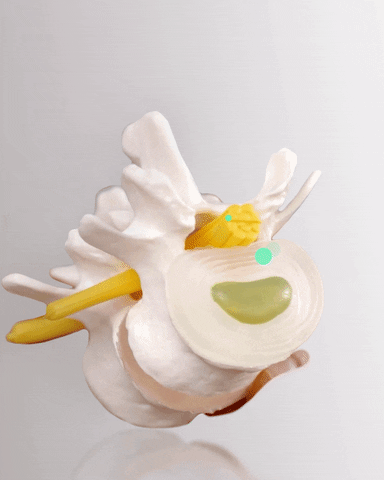- Field Guide to Back and Neck Pain
- Posts
- Abridged Anatomy: Intervertebral Discs
Abridged Anatomy: Intervertebral Discs
Brief anatomy lessons to help better understand your pain and where it comes from.

Anatomy of Your Spinal Discs

Good Morning! This is The Field Guide to Back and Neck Pain, the newsletter to stay up to date on treatments and symptoms of back pain, neck pain and other chronic pain conditions. Welcome to all new readers! To those that have been here before, thank you, it’s so good to see you again.
Here is what you can expect from today’s edition:
Anatomy of the Spinal Discs
News: Healthy habits to decrease your depression risk
Anatomy of the Spinal Discs
The intervertebral discs are important structures located between the vertebrae of the spine, providing cushioning, support, and flexibility to the spinal column. They consist of several components and have a unique anatomy that allows them to perform their crucial functions.
Let’s review the components that make up the intervertebral discs
Annulus Fibrosus: This is the tough, outer layer of the intervertebral disc. It is made up of concentric layers of fibrous tissue. The annulus fibrosus is primarily composed of collagen fibers arranged in a crisscross pattern. These fibers provide strength and stability to the disc and help contain the inner nucleus pulposus.
Nucleus Pulposus: The nucleus pulposus is the inner core of the intervertebral disc. It has a gel-like consistency and is primarily composed of water, proteoglycans, and a few collagen fibers. The high water content gives the nucleus its characteristic ability to absorb and distribute compressive forces, allowing the disc to act as a shock absorber.
Cartilaginous Endplates: These are thin layers of cartilage located at the top and bottom of each intervertebral disc. They serve as a barrier between the disc and the adjacent vertebral bodies, allowing for the exchange of nutrients and waste products between the disc and the surrounding tissues.
Blood Vessels and Nerve Endings: Unlike many other tissues in the body, intervertebral discs have a limited blood supply. They receive nutrients and oxygen through diffusion from nearby blood vessels in the vertebral bodies. Nerve endings are also present in the outer annulus fibrosus, making the discs sensitive to pain and other sensations when damaged or under stress.
Over time, intervertebral discs can degenerate or become damaged (see right side of above image) due to factors like aging, injury, or poor posture. When this occurs, individuals may experience conditions such as herniated discs, degenerative disc disease, or spinal stenosis, which can lead to pain, numbness, tingling, and other symptoms. Check out our recent article on Degenerative Disc Disease to learn more and find out some treatments for DDD.
Keep reading to see a brief overview of the role of the intervertebral discs!
What is the role of the Intervertebral Discs
The intervertebral discs play several crucial roles in the spine.
Shock Absorption: The nucleus pulposus absorbs shocks and impacts, reducing the risk of injury to the spine during activities like walking, running, and jumping.
Flexibility: The discs allow for flexibility and motion between adjacent vertebrae, enabling movements like bending, twisting, and leaning.
Spacing and Alignment: They help maintain the spacing and alignment of the vertebrae, contributing to the stability of the spine.
Load Distribution: The discs evenly distribute the weight and load bearing across the spinal column, preventing excessive stress on any one vertebra.
Understanding the anatomy of intervertebral discs is crucial for comprehending spine health, injuries, and related medical conditions. Ask your doctor if your back or neck pain could be coming from your intervertebral discs. They can go into more detail with you about diagnosis and treatment options.
In the news…
These daily habits can have a big effect on your depression risk. Check it out in the article below.
In case you missed it…
Resources
Check out our resources below to help get the most out of your doctor’s appointments. Or get them for FREE by sharing this newsletter with a friend! See the Referrals Section below.
Advertising in the Field Guide to Back and Neck Pain
Interested in advertising directly to readers of this newsletter? Get in touch today by responding directly to this email.
About the Author
Les is an invaluable member of the team! He is the Lead Writer for the Field Guide to Back and Neck Pain newsletter. However, Les Payne is just a Pen Name to protect the identity of our expert Lead Writer who is an actively practicing, board-certified expert in the treatment and prevention of back and neck pain as well as other acute and chronic pain conditions. He has years of experience in this field and has treated over 15,000 patients with pain of all kinds!
Disclaimer: This publication is provided for educational and informational purposes only and does not constitute providing medical advice or professional services. The information provided should not be used for diagnosing or treating a health problem or disease, and those seeking personal medical advice should consult with a licensed physician. Always seek the advice of your doctor or other qualified health provider regarding a medical condition. Never disregard professional medical advice or delay in seeking it because of something you have read in this publication or website. If you think you may have a medical emergency, call 911 or go to the nearest emergency room immediately. No provider-patient relationship is created by this publication or web site or its use. Neither the administrator nor its employees, nor any contributor to this publication or web site, makes any representations, express or implied, with respect to the information provided herein or to its use.






